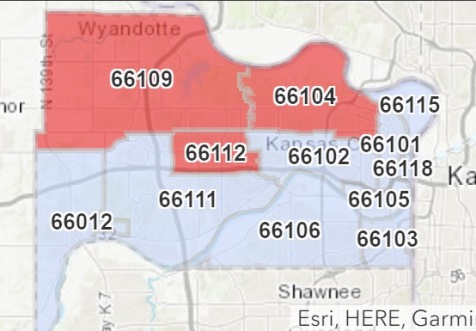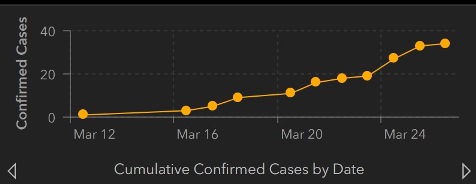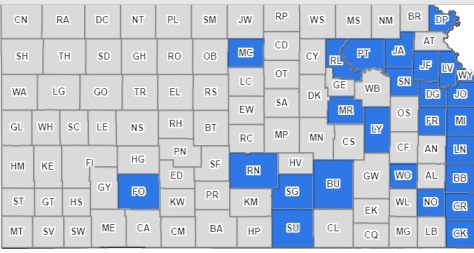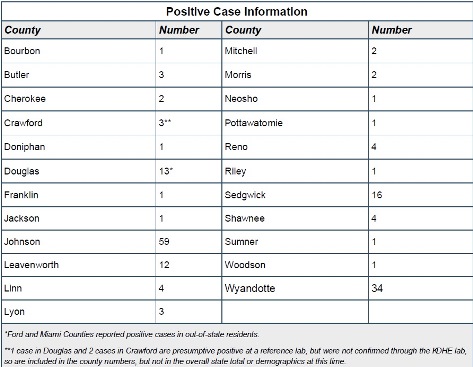Wyandotte County now has a third death related to COVID-19 and a new total of 37 positive cases, according to Terrie Garrison, interim director of the Unified Government Health Department.
She made her report at the 6 p.m. Thursday meeting of the UG Board of Health at City Hall. The numbers of patients were updated from earlier in the day.
Garrison said the Health Department staff has worked hard to get ahead of the pandemic in Wyandotte County.
“It’s only been 14 days since the very first case of COVID-19 hit Wyandotte County, and there have been so many strides taken in such a very short amount of time,” she said.
Nineteen of the cases had to be hospitalized, according to Garrison.
The Health Department set up a self-report website for Wyandotte County residents, where individuals can report their symptoms and the severity of the symptoms.
Within 24 hours, medical students and residents get in contact with the individuals who have self-reported, she said. They assess the symptoms and decide if it is probably COVID-19, she said.
There are currently 37 lab-confirmed positive COVID-19 cases here, and another 37 probable cases out of the 84 that were self-reported, she said.
The Health Department also is monitoring the spread with the self-reports because they are not getting as heavy testing as they would have liked at first, she added. The self-reports are allowing them to monitor the epidemiological spread in the county of the possible cases, she said. When the COVID-19 outbreak started here, there was a shortage of tests.
The University of Kansas Hospital in Kansas City, Kansas, reported this morning that they had 27 tests that were pending, 16 confirmed cases of COVID-19 in the hospital, including four in intensive care unit and two on ventilators, Garrison said.
“We are continuing to do contact investigations with all of our known positives, as well as finding out who they’ve been in contact with, where those contacts have been, and trying to do the self-quarantining individuals who have a possibility of having the COVID,” she said.
Dr. Allen Greiner, who issued the stay-at-home orders on Tuesday for Wyandotte County, said he and other staff were pleased with the results.
They have received many questions about the orders, and the police department now has put up a full-time call-in line from businesses to determine what are essential activities and essential businesses, he said. Many have asked if they needed to carry some sort of letter, and he has told people they won’t be stopped if it is necessary.
It is something they want people to evaluate for themselves and their businesses and make smart decisions to protect their customers, clients, employees, families and themselves, as well as the community at large, he said.
He said the Health Department went out to visit funeral homes Thursday, after being asked questions, and the department is offering guidance.
In answer to a commissioner’s question, Dr. Greiner said that mortuary services have to continue, but the Health Department wants to have only a maximum of 10 persons in a funeral home for a service. He said one funeral director asked a large number of family members in a parking lot to disperse, to keep the number under 10.
Other facilities wanted to rotate with 10 persons coming in, then going out after a short while, with another 10 coming in.
“We made it clear it was not appropriate under the order,” he said. He added that would expose a lot of people to risk.
Dr. Greiner said they will be working in the next day or two to get a guidance document completed, so that all the funeral services will have the same guidelines.
“The primary thing we’re trying to avoid with all this is what we’re hearing is happening in New York, where the health care system just gets completely overwhelmed,” he said.
He said there are lot of serious cases coming out of a small number of total cases, and they know this community is vulnerable, so they have been working closely with both hospitals here. Pre-planning at both hospitals has been really strong, he said. There are fears about whether there will be adequate personal protective equipment, he said.
“But if we can keep the numbers down as we hope to with the stay-at-home order, there should be capacity to take care of the sick folks that need it,” Dr. Greiner said.
He said there has been good movement the last four to five days to increase testing capacity in Wyandotte County and two hospitals. The Health Department is trying to assist and get more drive-through testing started, he said.
KU Hospital started testing in its own labs two days ago, he said, which is helping to reduce their backlogs. They were previously sending tests out and waiting about four days to get results back. That became a problem, as they were using a lot of the disposable personal protective equipment, which has been in scarce supply, while waiting four days. Now the turnaround is about 10 to 12 hours with their own lab, he said.
He added there are plans to launch a downtown testing site. They will pursue some grant funding from local foundations.
In answer to a question, Dr. Greiner said KU Hospital reported that 80 to 90 percent of the tests the past two weeks had come back negative.
Dr. Greiner said that Dr. Erin Corriveau, from KU Medical Center, has been helping the past 10 days.
Juliann Van Liew, planning and operations manager at the Health Department, said the UG Health Department has developed a website with information for residents and businesses.
It has a section for Wyandotte County residents to self-report symptoms. She said many residents said they appreciate a call within 24 hours from a person that provides them with some guidance on what to do.
The UG also has a section for persons to report a need for food. Some patients with COVID-19 symptoms are isolating at home and cannot go out to get food, and other persons have lost jobs and cannot afford it. The requests will be funneled to Cross-Lines Community Outreach agency and volunteers will start taking food to those who need it on Friday, she said. Other agencies may get involved in the assistance effort, also.
Those who want to volunteer or donate funds may also leave their names on a section of the website. That information will be funneled to agencies in the community.
The UG launched a “dashboard” page on its COVID-19 site with updates, a map and a graph earlier Thursday, and it will be updated every evening, she said.
Dr. Erin Corriveau said they had heard from the 211 telephone line that calls are up about 300 percent.
Cross-Lines has reported they were usually helping 35 families before COVID-19 and now they are assisting about 160 families.
“That increase is real and we’re seeing that now,” she said. “There s a real concern for the supply of food.”
They are asking for donations and writing grants to get funds for food for people in the community, she said.
The Health Department also is working with multiple homeless agencies including the Greater Kansas City Committee to End Homelessness to secure a quarantine facility where homeless individuals who may be positive for coronavirus can stay there safely, away from others, and not pass the virus on, she said. The shelter would have about 50 beds with showers. A formal proposal has been written, she said.
Last week it was rare to get a call, but there is currently a big uptick in calls for shelter space, she added.
Janell Friesen, public information officer for the Health Department, reported the UG is trying to get the word out in different ways about COVID-19, including through the news outlets, the UG newsletter, social media, videos, and other methods. In the future they are considering sending out a postcard to reach residents. Fliers, posters and cards also are being produced.
Besides information, the UG’s COVID-19 website is posting employment with a link to the Workforce Partnership, as many persons have lost jobs or have fewer hours, she said.
Individuals may access more information about the stay-home orders through the frequently asked questions pages on the website, she said. The orders also are posted there.
At the 7 p.m. meeting, the UG Commission approved a resolution allowing the UG administrator or the chief medical officer to appoint one or more deputy medical officers in response to COVID-19.
To see a video with more information from this UG meeting, visit https://www.youtube.com/watch?v=b5jtuFuBscQ.
The UG COVID-19 page is at https://alpha.wycokck.org/Coronavirus-COVID-19-Information





